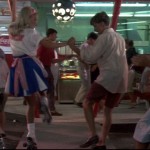This post, originally from 2010, is being reposted again (it returned to the front page last October) as a follow-up to the recent shot of Bernie Sanders as a college student. While the bottom photo appears to be a boatneck sweater, the others all appear to be crewnecks worn high in the front on purpose. Top photo has been added to the post.
* * *
In our last “Secrets of Sprezzatura” post, we showed you how to achieve an air of ars-est-celare-artem nonchalance by wearing your shirt collar deliberately messed up while feigning obliviousness to it.
For this installment, we look at the excruciatingly correct way to wear a crewneck, though we’re at a loss to explain how it became correct.
While neatfreaks wear their crewnecks high in the back and rounded in the front, the more nonchalant way is to wear it low in the back and straight across the front, suggesting you hastily threw the sweater on in order to keep warm, with no concern for your appearance.
Crewnecks are worn this way regardless of how they’re cut, with or without a tie. You see this both in historic images and cinematic recreations of the Ivy heyday, such as “Dead Poets Society.”
I asked a number of sartorial sages to shed light on the origins of this custom, but none could offer an answer. If you grew up with your father or peers showing you the “right” way to wear a crewneck, leave a comment and let us know.
The above photo (exhibit A), plus exhibits B and C below show front views, while D shows a side view of a correctly worn crewneck, wonderfully demonstrated by the venerable French teacher in the movie “School Ties.”
Finally, for double deshabille points, combine the high-in-front, low-in-back way of wearing a crewneck with a messed-up-collar oxford. — CC
















That definitely looks like the way my father wears them, though I doubt he could tell you why. For reference, he grew up in Somerville and Cambridge in the 50’s. I can’t remember seeing him in a sweater that isn’t a crewneck, and he wears them just like the fellow in Exhibit A, with just a peak of collar showing in front.
You can easily achieve this effect…if you put it on backwards
Not to nitpick, CC, but it should be “artem.” (I live for chances to validate my Classics degree.)
I think you’ve got a Latin problem here, Christian. The quote should read: ars est celare artem. Ars is a third declension noun, and artem is the accusative singular, which should be used here, since the word is the direct object of the preposition celare. Okay: enough pedantry! This is another interesting post!
Latin fixed; glad no one’s complained about my using it as a modifier. I should probably hyphenate it.
I wonder if a small neck hole would originally cause this look.
Isn’t it simply the fact that wearing it low in the front shows your undershirt and wearing it high/straight is a means of preventing that “unsightly sight”.
That hardly explains the men who are wearing a tie.
I’m certainly no neat freak, but I prefer it high in the back and low in the front. Personally, it’s more comfortable that way as I don’t have yet another layer of clothing pressing against my throat.
I know this is splitting hairs but the third picture is a boatneck.
Indeed it is. Boyer and I wondered if what I was seeing in some of the images was boatnecks; we also wondered if it was a necktie that was causing the effect. But I’m convinced you see this with standard crewnecks, with or without a tie.
I just like wearing that way. I have no clue as to here I learned it.Now and again someone (almost always a woman) will try and turn it around with me still in it. Quite Fun.
Always Bumby
I always thought it was just caused by older cuts having more of a wider neck, similar to a boatneck. I remember seeing a still from an old movie with a cotton sweatshirt with this shape over an Oxford, and I’ve got a Japanese repro of that style. I wear ties in the winter just to get this effect (affect), much to the bemusement of my friends.
This is how it was done at my boarding school.
Alas, I’ll be the contrarian. To my eye, the high collar looks uptight and a bit prissy, not non-chalant. Then again, I hardly wear sweaters and am therefore not an expert. Also, the t-shirt problem is largely solved by a v-neck.
CC wrote: “That hardly explains the men who are wearing a tie.”
No it doesn’t. And I can’t tell you why.
But when I wore my first crew neck Shetland – a Christmas gift from my sister who lived in Bermuda – and OCBD to public high school in Virginia circa 1965 there was always a stripe or paisley silk tie, invisible but for a slight bulge below the sweater collar. I wore it that way because every other guy at school wore it that way.
“The past is a foreign country; they do things differently there.”
You gentlemen are overthinking this. None of the above sweaters are the same or have the same neck. Nor are any of the crew necks necks’ knitted like a standard old school crew neck, like a shaggy dog. Besides the same sweater will fit different on different neck sizes and body build. Tie or no tie is a personal preference, there is no correct rule. Personally, if I’m wearing a tie the sweater will be v-neck.
I’m with Mac McConnell: I don’t know that it’s ever occurred to me to even try to wear a crew-neck over a tie; that’s what v-necks are for.
Circling back to the Latin, the syntax feels vulgar to me. Perhaps “ars celare artem est” would be a more prisca structure. Quid cogitatis?
Dad always wore sweaters like this. I thought it was ugly when I was younger. I still think it’s ugly.
I think the point was that these old-school guys didn’t own v-necks, as crews were the default sweater. When they needed a layer of warmth, that’s what they put on.
I think Paul Fussell has a passage in his book “Class” about this, pointing out that the v-neck is middle class because it shows everyone emphatically that you have a tie on.
As for the Latin, I first came across that phrase 20+ years ago, probably in an old dandy text, possibly by Max Beerbohm. That’s how it was rendered.
as to the Latin, I think ars celare artem est would be the most natural word order. And it’d be even more natural to omit the copula, hence ars celare artem.
http://www.merriam-webster.com/dictionary/ars%20est%20celare%20artem
Golly! This happens to me every time I put on a crewneck. Good to know it is acceptable not to “fix” it.
Also, judging from the pictures, it appears one needs to also wear a sweater one/two size(s) too large? The line/stitching connecting the sleeve with the body should sit on your shoulder and not your bicep, no? Much like pic #2 and def. not like pic #4!
In the Heyday it was never shoe, pardon the mixed metaphor, to gild the lily with a either a cashmere or Shetland crewneck sweater under a sport coat, OCBD with tie. The preference in cold climes was a sport vest.
Thanks for the reminder, Mr. Press. Even though the Ivy Heyday was a bit before my personal heyday, I am a fan of the sport vest. I bought my first from Polo in the 80s, but it has unfortunately gone to Goodwill, the victim of a moth hole. A red flannel number from the Andover Shop sometimes gets an airing at Christmas parties and a cream Tattersall version from an equestrian shop occasionally makes an appearance under a tweed sport coat. I also have a tobacco-colored doeskin suede vest from Brooks that goes well with my brown tweed suit. I like the look, but it is definitely not an everyday thing. It’s not really go-to-hell, but it is not businesslike enough for work, and a bit dandyish even for most social occasions. Fortunately they don’t take up much room in the closet, and I generally get a complement or two when I trot one out. My stockbroker and Billax are among the rare contemporary exemplars of the look, but I encourage others to take up the cause.
“The line/stitching connecting the sleeve with the body should sit on your shoulder”
Never buy a sweater with the arms sewn on at the shoulder, it should be raglan sleeves or similar. The sweater will fit much better, look better and last longer. Plus no shoulder nipples. 😉
“The preference in cold climes was a sport vest.”
But wouldn’t that be middle class because it shows everyone emphatically that you have a tie on. 😉
Though I generally find Fussell’s study of class and its expressions incisive, I’ve never been sold on his hierarchy of sweater necks. I’m afraid he’s simply over-applying his principle of “more display=middle class.”
Sweaters moved from strictly athletic to casual occasions in the early 20th century. If you look at pictures of men like the Prince of Wales in the 1920s, these sweaters were almost always v-necks. Rich Americans following British aristocrats in adopting sweaters for casual situations also mostly wore v-necks (that exposed their ties!) in the interwar years.
While it’s true that mid-century Ivy through the 80s (at which point Fussell was writing) did certainly come to prioritize the crew neck, I don’t think it was because the v-neck was somehow too middle class. (And look at those often-shared LIFE photos of the young men in class at Princeton in the 1950s – you’ll see v-necks still mingling with saddle shoulder Shetlands.) The trend towards crewnecks in America, I believe, must have had other causes.
Fussell said the V-neck was for prols or the lower/working classes, I believe. Not home to check my copy of CLASS. It was fine to wear with a sport coat and tie but it helped if the coat was a little larger if worn with the sweater. The crew, that is.
My first crewneck was a lovat green Shaggy from Press’ store in Harvard Square in the late fifties. The front was high, the back low. This generation Shaggy is the reverse and they seem to creep up in the rear. Shag creep? Seldom wear one with a tie these days.
You are correct. V-necks are for the middle class down to upper prole according to Fussell.
What about tennis/cricket sweaters? They are always V-necks, but are they middle class?
(This is a sincere question, just in case anyone is wondering.)
I wore one today on the courts with an Indian, Bulgarian, and the guy that won the Emmy for designing the opening titles of “Mad Men.”
Not sure what class that makes us…
Seriously though, that sweater would seem to be in its own category, high in class and low in neck.
Henry, the short answer is no.
Now, for a long answer, which I hope is justified by your sincerity. As noted, Paul Fussell’s “Class” (1983) is the source of this relegation of the v-neck to the middle class (page 60). It is an illuminating study of class and its signals. It applies a small number of principles to a much larger number of instances to explain the coherency of the signals exhibited by each class. One of Fussell’s primary principles is that conspicuous display is indicative of the middle class.
This is certainly correct. Applying this principle of “overt display=middle class” today, you can think of the palatial gilded kitchen of a Real Housewife of Wherever as opposed to the simple kitchen of an actual upper-class house that is rarely if ever visited by its owner or his guests as it is the domain of the help. Granite, stainless steel, and ornate range hoods do not say upper class as much as, “I spend a lot of time in here and force my guests to do the same,” as is the middle-class habit.
In consigning the v-neck to the middle class because it doesn’t cover your tie entirely, Fussell made the error of hastily applying a solid principle to an instance where it does not fit, as academics can easily and understandably do in wide-ranging studies. V-neck sweaters do not have middle-class origins and certainly did not signal “middle-class” for the first half of the 20th century. The Duke of Windsor was not middle class. John Lindsay was not middle class (by American standards). Cricket sweaters are not middle class.
Yes, Shetland and other crewnecks grew dominant in Ivy style after WWII, but not because the v-neck was somehow too middle-class. I would guess the real explanation would lie more in a look at post-war American global dominance and a relaxation of a dependence on aristocratic British style among W.A.S.P.s, or perhaps in football being the school sport for W.A.S.P. boys (rather than cricket), or in any number of reasons. I’m not sure though, since I haven’t taken the time to analyze sufficient data on this topic. In any case, it makes no sense to imagine that mid- and later-20th century men saw the middle class as the provenance of the v-neck or the v-neck as the province of the middle class.
Taking Fussell’s footnote of an error as an accurate description of the class and wardrobe choices of countless men, or as a binding prescription for men today aspiring to dress in a higher class register, is reductive. It is like taking the (often given) proscription against short-sleeve Oxfords and other sports shirts as Yankee gospel. Yes, it is an upper-class habit (going back to turn-of-the-century Brits) to wear a long-sleeved shirt in warm weather, but there is ample evidence today and in historical sources of short-sleeved sports shirts being perfectly acceptable among the rich. “Take Ivy,” for example, records long- and short-sleeved sports shirts worn with shorts, just as it does v-neck and crewneck sweaters on campus.
Thank you, P.M.J.
You forgot to add the word “not” in the title for this post.
Hell’s bells…
Great piece, incisive comments. Alas, in my opinion, Ivy Style is the last of the Ivy-related sites worth checking anymore. At least, it’s the only one I go to.
Does anyone else here recall the Ivy tradition of wearing a sweater vest with the bottom turned upwards like a cuff? It would bring it to waist level like an Eisenhower jacket. I haven’t worn one that way in years, but I distinctly remember it as a common practice at college in the 50’s. I don’t know where that came from, either.
Those images from the Poughkeepsie Regatta are interesting. My college is right on the Hudson and now owns Cornell’s former boathouse. In our dining hall, there are many pictures from the crew days. A lot of turtleneck sweaters, oddly.
I started wearing my boatneck high-front and money suddenly started appearing in my pocket. I also have a strange twitch in my biceps, like I am compelled to row…..
Similar to Gregorious Mercator above, I always pull the crewneck down in front when I wear it with a tie because it shows off the tie and decreases the amount of material around my throat. That being said one might ask, “Well why not a v-neck sweater then?” Well, I don’t like the way they look at all. A crewneck looks more finished to me whereas a V-neck looks too showy and incomplete. If I wear a crewneck and OCBD without a tie I just leave the sweater where it falls when I pull it on, letting the material and cut of the sweater find its own place. Also, I don’t wear v-neck sweater vests because I look too much like a fuzzy beer keg. A bald fuzzy beer keg.
Jerry
I do recall my father wearing a sweater vest in the late 1950’s and early 1960’s in that manner. I also recall that my dad would wear thin sweater vested tucked into his trousers. I believe this was commonly done in the 1930’s, 1940’s and 1950’s.
Looking at these pictures, this occurs to me: it’s what a person brings to the moment–or event or gathering or institution or school or…–that really matters. Such a diversity here.
Long after the Look in question has been disaffiliated with clubs and schools that once functioned as enclaves for WASPs with plenty of money, it remains very much (just), well, a look. A style. If any affiliations have a chance of standing the test of time, it’s probably rustic New England and old New York. I mean, very few if any rich white folks walking the grounds of UVA or Sewanee give a damn about the fit of a shetland sweater collar. Even if they should.
Hell, they probably don’t even own a shetland wool sweater.
At Lawrenceville in the early sixties we’d pull up the front to hide our lack of a tie. Then the housemaster would give slight tug on the front to see if we were cheating on the dress code or in compliance.
Seeing the picture of the guy wearing his major “P” brings back some memories. Those black sweaters were very heavy, only suitable for really cold weather. Also, with that style of neck the sweaters can be worn backwards so the letter is on one’s back, generally the way they were worn at Lawrenceville. The letter itself was made of felt.
Please excuse my late arrival to this topic and if someone has previously mentioned my observation. The photos showing the fellow wearing a bowtie with the crewneck looks a little like he’s strangling.